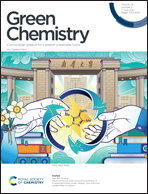Controlling product selectivity with nanoparticle composition in tandem chemo-biocatalytic styrene oxidation†
Abstract
The combination of heterogeneous catalysis and biocatalysis into one-pot reaction cascades is a potential approach to integrate enzymatic transformations into existing chemical infrastructure. Peroxygenases, which can achieve clean C–H activation, are ideal candidates for incorporation into such tandem systems, however a constant supply of low-level hydrogen peroxide (H2O2) is required. The use of such enzymes at industrial scale will likely necessitate the in situ generation of the oxidant from cheap and widely available reactants. We show that combing heterogeneous catalysts (AuxPdy/TiO2) to produce H2O2in situ from H2 and air, in the presence of an evolved unspecific peroxygenase from Agrocybe aegerita (PaDa-I variant) yields a highly active cascade process capable of oxidizing alkyl and alkenyl substrates. In addition, the tandem process operates under mild reaction conditions and utilizes water as the only solvent. When alkenes such as styrene are subjected to this tandem oxidation process, divergent reaction pathways are observed due to the competing hydrogenation of the alkene by palladium rich nanoparticles in the presence of H2. Each pathway presents opportunities for value added products. Product selectivity was highly sensitive to the rate of reduction compared to hydrogen peroxide delivery. Here we show that some control over product selectivity may be exerted by careful selection of nanoparticle composition.



 Please wait while we load your content...
Please wait while we load your content...